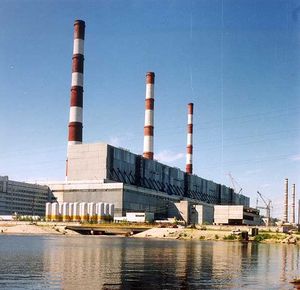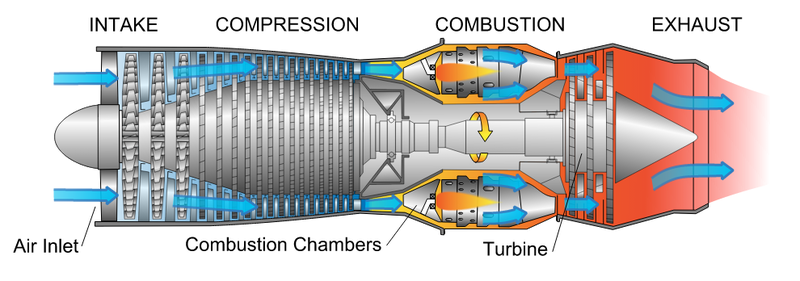Natural gas power plant

Natural gas power plants generate electricity by burning natural gas as their fuel. There are many types of natural gas power plants which all generate electricity, but serve different purposes. All natural gas plants use a gas turbine; natural gas is added, along with a stream of air, which combusts and expands through this turbine causing a generator to spin a magnet, making electricity. There is waste heat that comes from this process, because of the second law of thermodynamics. Some natural gas plants use this waste heat as well, which is explained below.
Natural gas power plants are cheap and quick to build. They also have very high thermodynamic efficiencies compared to other power plants. Burning of natural gas produces fewer pollutants like NOx, SOx and particulate matter than coal and oil.[2] On the other hand, natural gas plants have significantly higher emissions than a nuclear power plant. This means that air quality tends to improve (ie. reduces smog) when switching to natural gas plants from coal plants—but nuclear power does even more to improve air quality.
Despite the improved air quality, natural gas plants significantly contribute to climate change, and that contribution is growing (see pollutant vs greenhouse gas).[3] Natural gas power plants produce considerable carbon dioxide, although less than coal plants do. On the other hand, the process of getting natural gas from where it's mined to the power plants leads to considerable release of methane (natural gas that leaks into the atmosphere). As long as natural gas plants are used to produce electricity their emissions will continue to warm the planet in dangerous ways.
Types
There are two types of natural gas power plants: Simple cycle gas plants and combined cycle gas plants. The former consists of a gas turbine connected to a generator and the latter consists of a simple cycle plant, combined with another external combustion engine, operating on the Rankine cycle—hence its name "combined cycle".
The simple cycle is simpler but less efficient than the combined cycle. However, simple cycle plants are able to dispatch faster than coal-fired power plants or nuclear plants. This means they can be turned on or off faster in order to meet societies electricity needs.[4] Often needed on the grid with wind power and solar power, its purpose is to meet the fluctuating electricity needs of society, known as peaking power. Combined cycle plants are more efficient because it makes use of the hot exhaust gases that would otherwise be dispelled from the system. These exhaust gases are used to boil water into steam—which can then spin another turbine and generate more electricity. The thermal efficiency of the combined cycle can get up to 60%.[5] Moreover, these plants produce one third of the waste heat of a plant with a 33% efficiency (like a typical nuclear power plant or an older coal power plant). See the thermal efficiency page for more information on this.
The cost of a combined cycle plants is generally higher since they cost more to build and run. The EIA estimated that for a simple cycle plant the cost is about US$389/kW, whereas combined cycle plants are US$500-550/kW.[6]
The use of natural gas accounts for around 23% of the world's electricity generation (see the data visualization below). This is second only to coal, and the fraction that is natural gas is expected to grow in coming years. This means that natural gas's contribution to climate change will continue to grow.
Operation
Natural gas turbines are theoretically simple and have three main parts as seen in Figure 2:[7]
- Compressor: Takes in air from outside of the turbine and increases its pressure.
- Combustor: Burns the fuel and produces high pressure and high velocity gas.
- Turbine: Extracts the energy from the gas coming from the combustor.

Combined cycle
The simple cycle stops here, however, the combined cycle extends beyond this to use more of the energy created in the combustion. The exhaust gases are made to flow towards the next unit, called the heat recovery steam generator (HRSG).[9] The HRSG is essentially a heat exchanger, in which the hot gases boil pre-heated water into steam. The steam then expands through a turbine, generating electricity. Once the steam has passed through, it condenses and is recycled through.
Cogeneration
Natural gas plants produce waste heat, like all heat engines. Sometimes this waste heat is captured to heat homes or for industrial uses. This process is known as cogeneration.
World Electricity Generation: Natural Gas
The map below shows which primary energy different countries use to generate their electricity from. Natural gas is seen in red. Click on the region to zoom into a group of countries, then click on the country to see where its electricity comes from. Notable countries include the United States, Russia, Saudi Arabia, and Iran.
For Further Reading
- Natural gas
- Natural gas formation
- Simple cycle gas plant
- Combined cycle gas plant
- Pollutant vs Greenhouse gas
- Or explore a random page
References
- ↑ Wikimedia Commons [Online], Available: https://upload.wikimedia.org/wikipedia/commons/2/2e/Surgut_%28060%29.jpg
- ↑ Environmental Law Institute Research Report, "Cleaner Power the benefits and costs of moving from coal generation to modern power technologies", 2nd edition, May 2001.
- ↑ Carbon dioxide and methane emissions are not included in air quality. Burning natural gas releases both, therefore, it contributes to climate change, while improving air quality.
- ↑ T. Johnson and D. Keith, "Fossil electricity and CO2 sequestration: how natural gas prices, initial conditions and retrofits determine the cost of controlling CO2 emissions", Energy Policy, vol. 32, no. 3, pp. 367-382, 2004.
- ↑ Siemens, Efficiency Record of Combined Cycle Power Plant [Online], Available: http://www.siemens.com/innovation/en/news/2011/efficiency-record-of-combined-cycle-power-plant.htm
- ↑ Paul Breeze. (2005) Power Generation Technologies [Online Book], Available: https://books.google.co.uk/books?id=D9qSDgTbRZoC&pg=PA59&dq=%22Simple+cycle+combustion+turbine%22&hl=en&sa=X&ei=8A4sUYaND4vA9QSSqIDIDw#v=onepage&q=%22Simple%20cycle%20combustion%20turbine%22&f=false
- ↑ Brain, Marshall. "How Gas Turbine Engines Work" 01 April 2000. HowStuffWorks.com. [Online], Available: <http://science.howstuffworks.com/transport/flight/modern/turbine.htm> 28 May 2015.
- ↑ Wikimedia Commons [Online], Available: https://upload.wikimedia.org/wikipedia/commons/4/4c/Jet_engine.svg
- ↑ Wartsila, Combined Cycle Plant for Power Generation: Introduction [Online], Available: http://www.wartsila.com/power-plants/learning-center/technical-comparisons/combined-cycle-plant-for-power-generation-introduction

